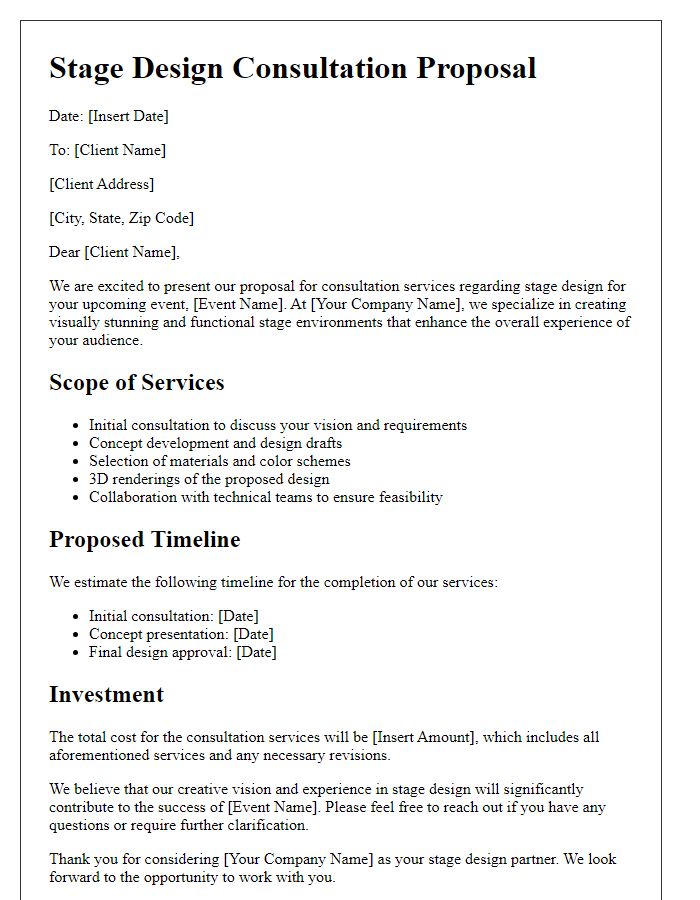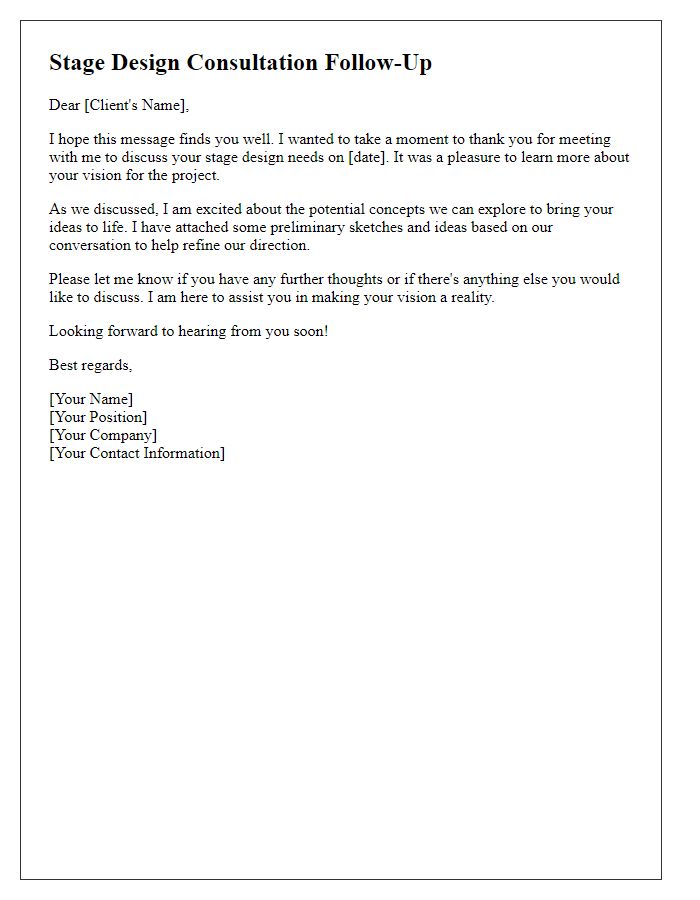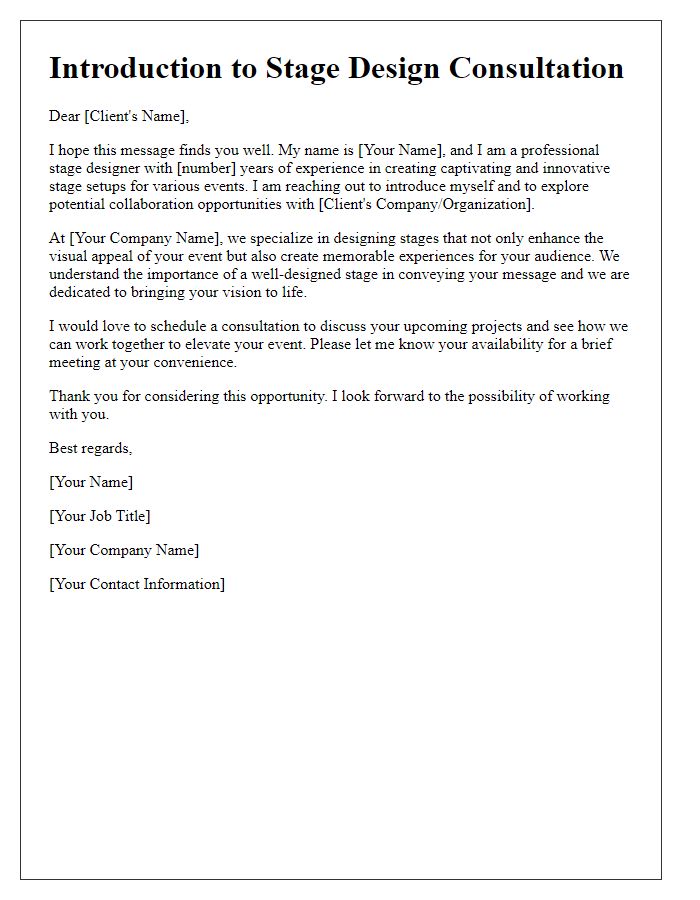Are you ready to bring your stage vision to life? Whether it's for a theater production, a concert, or a special event, stage design plays a crucial role in creating the perfect atmosphere. In this article, we'll explore key elements of effective stage design and how a professional consultation can elevate your project to the next level. So, grab a cup of coffee, sit back, and let's dive deeper into the world of stage design!

Client's Needs and Objectives
The client's needs for stage design include a versatile space for various performances, accommodating an audience of up to 500 people, while emphasizing accessibility and optimal sightlines. Specific objectives involve incorporating advanced lighting technology, such as LED fixtures with customizable color palettes, and a sound system capable of delivering high-quality audio across multiple genres. Additionally, the design must embrace a thematic approach aligned with the upcoming performance schedule, which features a diverse lineup of events spanning musical concerts to theatrical productions. Sustainable materials should be prioritized in the construction process, reflecting the client's commitment to environmental responsibility and innovation.
Budget Constraints
Stage design for theatrical productions often encounters budget constraints that can significantly impact the overall aesthetics and functionality of the set. Limited financial resources (e.g., under $10,000 for community theater) can restrict the use of high-quality materials, elaborate props, or advanced lighting systems. Designers may need to prioritize essential elements, focusing on cost-efficient alternatives to achieve the desired visual impact. Techniques such as recycling materials (e.g., repurposing wood or fabric from previous shows) and incorporating digital backdrops can enhance the design without incurring excessive expenses. Effective collaboration with producers and directors can yield innovative solutions, ensuring that creative visions align with financial realities while creating an engaging experience for the audience.
Space Dimensions and Layout
Stage design consultation involves critical evaluation of space dimensions and layout to create an effective performance environment. Venue measurements include width (up to 30 feet), depth (typically ranging from 15 to 40 feet), and height (ideal ceiling clearance of at least 12 feet), which influence sightlines and audience engagement. Seating arrangement options, such as proscenium, thrust, or arena setups, drastically affect acoustics and visibility. Consideration of backstage areas, including dressing rooms (usually 10x12 feet each), loading docks, and storage for props and costumes ensures seamless production flow. Specific elements like stage elevation and flooring materials--wood, carpet, or synthetic surfaces--impact both aesthetics and safety during performances. Effective staging requires meticulous planning of electrical outlets, lighting grids, and sound systems to create an immersive experience. Proper space utilization ensures that every audience member feels connected to the performance while providing actors with a conducive environment.
Aesthetic Preferences and Themes
In stage design consultation, aesthetic preferences play a crucial role in shaping the overall visual impact of a production. Designers often collaborate with directors to establish a cohesive theme that resonates with the narrative. For example, a contemporary play set in urban New York may utilize sleek lines, minimalistic furniture, and a color palette of muted greys and vibrant graffiti, reflecting the chaotic beauty of city life. Alternatively, a historical drama set in the Victorian era might embrace ornate details, rich fabrics, and warm, earthy tones to evoke a sense of nostalgia and grandeur. Understanding the target audience is essential; for instance, a children's theater performance might favor bright primary colors and whimsical designs that captivate young imaginations. Additionally, incorporating elements like projections, lighting schemes, and props can further enhance the chosen aesthetic, creating an immersive experience that aligns with the thematic goals of the production. The stage's spatial configuration should also be considered, ensuring that the set seamlessly transitions between various scenes and maintains visual interest throughout the performance.
Technical Requirements and Equipment
Stage design consultation focuses on essential technical requirements and equipment for successful productions. Key elements include lighting systems, such as LED fixtures and stage lanterns, which illuminate performances and enhance mood through color temperatures ranging from warm white (around 3000 Kelvin) to cool white (upwards of 6000 Kelvin). Sound systems, incorporating microphones like lapel and wireless options, offer clear audio delivery and audience engagement, crucial for effective communication. Rigging equipment, including trussing and hoists, supports set pieces and special effects, ensuring safety with load limits typically ranging from 250 to 1000 pounds, depending on the venue. Video projection systems, utilizing high-definition projectors, provide dynamic visual storytelling, critical during major events. Furthermore, stage surfaces such as hardwood or carpet affect acoustics and actor movement, impacting overall performance quality. Detailed planning is vital to harmonize these elements for a seamless experience.













Comments